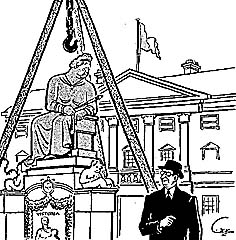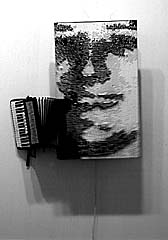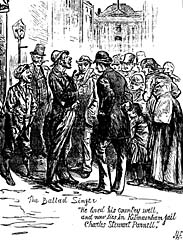|
There might be more to be learned through a careful tracing,
along paths not already guarded by the intellectual patrols of neo-imperialism,
of the border lines where comparative experiences of imperial victimization
and resistance meet and separate. These paths and borders, of course,
are not to be found on any Cartesian plane, nor will they stay in the
same place as we change our relation to them. . . .
Jonathan Boyarin, Storm from Paradise (1992)
In 1948, the Irish humourous journal Dublin Opinion published a cartoon
depicting the removal of the statue of Queen Victoria from in front
of Leinster House, the Irish seat of parliament. "Begob, Eamon", the
dejected Queen commiserates with de Valera, who had just lost office
in a general election, "there's great changes around here!" This was
indeed true, for the removal of the statue was a prologue to the official
declaration of an Irish Republic in 1949, an act which formally severed
the imperial connection that reached its apotheosis during her reign
in the nineteenth century.
Yet the Queen, for all her legendary absence of humour, may have had
the last laugh. Early in 1995, a public controversy ensued when University
College, Cork, as part of its 150th anniverary celebrations, decided
to exhume a statue of Queen Victoria which had been buried in the grounds
of the college since the 1930s, and put it on public display. This,
it was argued, was doing no more than setting the historical record
straight, a public acknowledgment of the fact that the university (originally
called Queen's College, Cork) was founded under a Victorian administration.

"Begob, Eamon there's great chances around here!" (The Queen Victoria
statue was being removed from in front of Leinster House after
the first party government had taken office.) Dublin Opinion,
August 1948
But this is not the way history, or rather memory, operates in a culture
with a colonial past; for 1845 was not only the year in which the Queen's
Colleges were established, it also marked the beginning of a more painful
reminder of Victorian rule, the Great Famine (1845&endash;8).1 At the
opening of the exhibition in which the statue was included, a protestor
was arrested for interrupting the proceedings with shouts of "What about
the Famine?" Though dismissed by some as a nationalist crank, the protestor
was also seeking to register a profound loss of memory, a traumatic
episode in Irish history that was no less effectively buried by officialdom,
both before and after independence, than Queen Victoria's moving statues.2
How is it possible to accommodate these disparate legacies of the Victorian
era within the narratives of Irish identity? According to one influential
strand in contemporary cultural theory, the answer lies in post-colonial
strategies of cultural mixing, that is, embracing notions of 'hybridity'
and 'syncretism' rather than obsolete ideas of nation, history or indigenous
culture. This, after all, is what is meant by the designation 'post'--colonialism,
and all its works and pomps, is deemed to be over and done with (if,
indeed, it ever existed in the first place), and the time has come to
draw a line over the past. In his highly schematic but instructive overview
of the four stages of culture formation mapped out by post-colonial
theory, Thomas McEvilley identifies first, the idyllic pre-colonial
period, the subject of much subsequent nationalist nostalgia; second,
the ordeal of conquest, of alienation, oppression and internal colonisation;
third, the nationalist reversal 'which not only denigrates the identity
of the coloniser, but also redirects . . . attention to the recovery
and reconstitution of [a] once scorned and perhaps abandoned identity';3
and fourth, the stage ushered in by the generation born after the departure
of the colonising forces, which is less concerned with opposition to
the colonial legacy--a situation which arose in India and Africa 'about
25 years after the withdrawal of colonialist armies and governments'.
It is this latter phase which lends itself to the free play of hybridity
and cultural mixing--and also to the distancing project of the diaspora
in which immigrants from ex-colonies re-negotiate their ancestral ties
in terms of the global demands of their new host culture.

Ballad num. 1, Philip Napier, 1992-1994. Photo by Michael McDonagh.
Courtesy of The Arts Council of N. Ireland.
But whatever about a week being a long time in politics, it is certainly
the case that a generation, or even a few generations, is a short time
in the centuries-old struggle against western colonisation. The belief
that the restoration of Queen Victoria's statue was an inoffensive gesture
in the context of an historical arc spanning 1845&endash;1995 could
only make sense if the Great Famine in Ireland was a thing of the past,
a phase of history that could now be safely consigned to the communal
Prozac of the heritage industry. But can the wounds inflicted by a social
catastrophe be so easily cauterised? Would anyone seriously suggest
that the traumatic lessons of the Holocaust shouldn't be as pertinent
in a hundred years' time as they are today? Or--to take an example that
touches directly on colonialism and the displacement of the diaspora--that
novels such as Toni Morrison's Beloved are valuable merely for their
re-creation of the ordeal of slavery as it was endured 150 years ago,
but have little to do with the lived experience of the African American
population in the contemporary United States?
What we are dealing with here are different registers of memory, one
that is contained and legitimised within the confines of the monument
and the museum, and the other having to do with the fugitive traces
of collective memory, as transmitted by popular culture, folklore, ballads
and so on. In this respect, the contestation of museum space in Philip
Napier's Ballad no. 1 at the "Beyond the Pale" exhibition is remarkable.4
It features an accordion mounted on a wall, whose intake and expelling
of air allows it to double up as an artificial lung attached to the
barely decipherable image of the republican hunger striker, Bobby Sands.
The blown-up photogravure effect of the image is achieved through small
nails, a reminder of the aura of martyrdom which surrounded Sands's
death on hunger-strike in 1981. The wheezing moans of the accordion
extend beyond the individual body, however, evoking some of the more
discordant strains in Irish vernacular culture. Not only do the eerie
sounds waft through museum space like the wail of the mythical banshee
in Irish folklore,5 but the instrument itself signifies traditional
music, more particularly the street singer and the popular ballads that
were repeatedly targeted by the authorities as cultural expressions
of insurgency. By linking the famished body with mourning and collective
memory, the off-key image becomes, in effect, a living monument for
the Famine and the dark shadow which it cast on the lung of the Irish
body politic.

The Ballad Singer, The London Illustrated News, 29 october, 1881.
The mythic resonances of the banshee and vernacular culture are also
evident in the figurations of hair and long female tresses central to
Alice Maher's recent work. Although the banshee is more often heard
than seen, sightings of the phantom figure portray her as an old woman,
combing her long white hair as she laments. In Maher's Familiar series,
undulating braids of hair are given an additional historical twist by
being recreated though the medium of flax--a material, according to
the artist, that is 'interwoven with a thousand meanings and histories'.6
One of the meanings is the association with women's work and the relative
financial independence which cottage industry afforded for women in
pre-Famine Ireland. Another historical connection, however, derives
from the destruction of the once-thriving Irish wool trade by British
colonial policy, and its replacement by a linen industry, based mainly
in Northern Ireland. The 'hybridity' of these exhibits is clear from
their indeterminate boundaries: between organic and fabricated materials,
nature and culture, native and newcomer.
Of course, there are proponents of hybridity who refuse to consider
Ireland as a suitable case for post-colonial treatment at all. Though
the authors of one 'comprehensive study' find the term 'post-colonial'
expansive enough to include not only the literatures of India, Africa
and the Caribbean, but also Canada, Australia and even the United States,
no place is found for Irish literature. The reason for this becomes
apparent later on, when Irish, Welsh and Scottish literatures are discussed
'in relation to the English "mainstream"':
While it is possible to argue that these societies were the first
victims of English expansion, their subsequent complicity in the British
imperial enterprise makes it difficult for colonized peoples outside
Britain to accept their identity as post-colonial.7
This remarkable statement (which appears to be under the apprehension
that Ireland is still part of Britain) only makes sense if one identifies
the Irish historically with the settler colony in Ireland, the Anglo-Irish,
thus erasing in the process the entire indigenous population--a view
closer, in fact, to 'Commonwealth' than post-colonial literature.8 This
indiscriminate application of the term 'post-colonial' is indeed a recurrent
feature of The Empire Writes Back, with the result that Patrick White
and Margaret Atwood are considered post-colonial in the same way as
Derek Walcott or Chinua Achebe.9 This is not to say, of course, that
some Catholic or indigenous Irish did not buy into hegemonic forms of
racism in the United States and Australia when they themselves managed
to throw off the shackles of slavery or subjugation. But it is important
to recognise this for what it is, a process of buying into the existing
supremacist ideologies, derived mainly from the same legacy of British
colonialism from which they were trying to escape. In Charles Gavan
Duffy's words, commenting on the upward mobility of some of the Irish
Catholic diaspora in Australia:
To strangers at a distance who read of Barrys, MacMahons and Fitzgeralds
in high places, it seemed the paradise of the Celts--but they were
Celts whose forefathers had broken with the traditions and creed of
the island [i.e., Ireland].10
This is an important corrective to the essentialist myth that racist
attitudes were already present in Irish emigrants-- by virtue of their
'white- ness', their backwardness, or 'national character'--before they
emigrated to Britain, the United States or Australia.11 What the immigrant
Irish brought with them from the homeland were not the habits of authority
fostered by the coloniser but, in fact, a bitter legacy of servitude
and ignominy akin to that experienced by native and African Americans.
Indeed, from the colonial perspective, the racial labels 'White/non-White'
did not follow strict epidermal schemas of visibility or skin colour
so that, in an important sense, the Irish historically were classified
as 'non-White', and treated accordingly. The widespread equation of
the 'mere Irish' with the native Americans in the seventeenth century
served as a pretext for wholesale confiscations and plantations, and
more ominous expressions of genocidal intent as in Edmund Spenser's
advice to Queen Elizabeth that 'until Ireland can be famished, it cannot
be subdued'.12 The transportation of the Irish to the New World featured
prominently in the 'white slave trade' in the seventeenth century, and
throughout the eighteenth and early nineteenth centuries the Penal code
which systematically excluded Catholics from citizenship and political
life rendered them, in Edmund Burke's phrase, foreigners in their native
land. There was no need to go abroad to experience the 'multiple identities'
of the diaspora valourized in post-colonial theory: the uncanny experience
of being a stranger to oneself was already a feature of life back home.

Imagined Truths, Willie Doherty, 1990.
As David Roediger remarks of the ambivalence of Irish attitudes to
racism in America, 'shared oppression need not generate solidarity but
neither must it necessarily breed contempt of one oppressed group for
another'.13 The need to define themselves as white presented itself
as an urgent imperative to the degraded Irish who arrived in the United
States after the Famine, if they were not to be reduced to servitude
once more. This was the political climate in which Ralph Waldo Emerson
could write:
I think it cannot be maintained by any candid person that the African
race have ever occupied or do promise ever to occupy any very high
place in the human family. The Irish cannot; the American Indian cannot;
the Chinese cannot. Before the energy of the Caucasian race all the
other races have quailed and done obeisance.14
It was in these circumstances that many Irish sought to identify with
the manifest destiny of whiteness, finding in the anti-abolitionist
Democratic party a vehicle for their social and political aspirations.
This, in effect, meant an uneasy accommodation with what Reginald Horsman
describes as 'American racial Anglo-Saxonism' and, as Roediger ruefully
comments, 'under other circumstances, Irish American Catholics might
not have accepted so keenly the 'association of nationality with blood--but
not ethnicity', which racially conflated them with the otherwise hated
English'. But, he continues: 'within the constrained choices and high
risks of antebellum American politics such a choice was quite logical.
The ways in which the Irish competed for work and adjusted to industrial
morality in America made it all but certain that they would adopt and
extend the politics of white unity offered by the Democratic party'.15
The point of drawing attention to the unhealthy intersection of Irish
Catholicism with supremacist Anglo-Saxon ideals of whiteness in the
United States is to underline the risks inherent in uncritical adulations
of 'hybridity' as an empowering strategy for diasporic or post-colonial
identity --particularly when it involves accommodation with the values
of powerful expansionist cultures already built on racism. As Ella Shohat
and Robert Stam put it, undue haste in deconstructing essentialist notions
of identity 'should not obscure the problematic agency of "post-colonial
hybridity"':
A celebration of syncreticism and hybridity per se, if not articulated
with questions of historical hegemonies, risks sanctifying the fait
accompli of colonial violence. For oppressed people, even artistic
syncreticism is not a game but a sublimated form of historical pain,
which is why Jimi Hendrix played the 'Star Spangled Banner' in a dissonant
mode, and why even a politically conservative performer like Ray Charles
renders 'America the Beautiful' as a moan and a cry. As a descriptive
catch-all term, 'hybridity' fails to discriminate between the diverse
modalities of hybridity: colonial imposition, obligatory assimilation,
political co-option, cultural mimicry and so forth.16
It is in this context that one should consider Willie Doherty's photographic
triptychs Fading Dream (1989) and Evergreen Memories (1989). In Fading
Dreams we see redolent details of imposing Georgian architecture dating
from the period in the eighteenth century when the majority Catholic
population were kept in bondage, and then the obsequious 'hybridity'
of reclaiming this heritage for a nationalist present by placing a brass
harp on a panelled door. The green letters overlaid on the images, however,
suggest that nostalgia--the 'fading dreams' and 'hospitable' welcome--for
imperial splendour is not restricted to the relics of the old order
but is possibly shared by the new 'nationalist' dispensation, notwithstanding
its official condemnations (it is not clear, for this reason, to whom
'Depraved' and 'Unknown Depths' refer to). As against this, Evergreen
Memories shows another neo-classical building which has been more violently
reclaimed by nationalist memory, the General Post Office in the centre
of Dublin, scene of the 1916 rebellion which declared an Irish republic.
On the one hand, this founding site of the state is an object of awe
and reverence ('Evergreen memories' of 'Resolute' revolutionaries);
but the site is also one of disavowal and rejection (it is not clear
whether the overlaid 'Psychopath' and 'Cursed Existence' emanate from
the imperial building itself, or from its new custodians, the post-colonial
state intent on forgetting its violent origins).17
In a similar vein, John Kindness's satirical panels for the DART (Dublin
Area Rapid Transport) trains show the colonial mimicry of the consumerist
Irish state as evidenced by the green bottle on the dinner table containing
DE sauce (as in Dail Eireann [i.e., the Government of Ireland], and
perhaps Eamon de Valera?). This craven hybridity is an imaginary rip-off
of the original HP sauce bottle (as in House of Parliament) which adorns
so many British dinner tables. The kind of homely ideology lodged in
domestic details is again apparent in Kindness's recent Belfast Frescoes
which depict, in comic-book fashion, scenes from an upbringing in Protestant
Belfast. The affectionate memory of the father's cigarette moving around
the room in the dark before breakfast is counterpointed by the imagery
on the teapot and cup of the ill-fated Titanic, the pride of the Loyalist
shipyards, which was sunk by an iceberg on its maiden voyage in 1912.
(In a later picture, a teapot displays the rose and thistle, emblems
of the union between England and Scotland, which initially constituted
modern Britishness.) The link between the innocent detail of the cigarette
and the imperial icon of the ocean liner is forged by the sustained
visual pun in the border of the image, in which the smoke of the cigarette
is gradually transformed into the fog and mist which concealed the iceberg
on the ship's fatal journey. The tigers, elephants and kangeroos in
the borders of subsequent images also harbour imperial fantasies, as
when the young boys are shown embarking on safari hunts in their neighbourhood
in Belfast. In a later sequence, the closed culture of loyalism is characterised
by an image of a Unionist election poster blocking out Labour and Nationalist
posters, and the young narrator and his friend being contemptuously
labelled as 'Fenian-lovers', not because they were nationalists but
merely because, as working-class children, they were not overtly Unionist
and supported Labour.

Art on the DART. John Kindness, (Dublin Area Rapid Transit). 1988
If Ireland does not quite conform to the post-colonial condition, it
is not for the reasons outlined by some critics--namely, that because
it is 'white' and situated in Europe, therefore it cannot have been
subject to colonisation.18 Anne McClintock is nearer the mark when she
advises that:
The term 'post-colonialism' is, in many cases, prematurely celebratory.
Ireland may, at a pinch, be 'post-colonial', but for the inhabitants
of British-occupied Northern Ireland, not to mention the Palestinian
inhabitants of the Israeli Occupied Territories and the West Bank,
there may be nothing 'post' about colonialism at all.19
'Post', in this context, signifies a form of historical closure, but
it is precisely the absence of a sense of an ending which has characterised
the national narratives of Irish history. This has less to do with the
'unfinished business' of a united Ireland than with the realisation
that there is no possibility of undoing history, of removing all the
accretions of conquest--the English language, the inscriptions of the
Protestant Ascendency on the landscape and material culture, and so
on. For this reason, there is no prospect of restoring a pristine, pre-colonial
identity: the lack of historical closure, therefore, is bound up with
a similar incompleteness in the culture itself, so that instead of being
based on narrow ideals of racial purity and exclusivism, identity is
open-ended and heterogeneous. But the important point in all of this
is that the retention of the residues of conquest does not necessarily
mean subscribing to the values which originally governed them: as Donald
Horne has argued, even the sheer survival of cultural artifacts from
one era to another may transform their meaning, so that the same building
(or, perhaps, even the same statue) 're-located' in a new political
era becomes, in a sense, a radically different structure.20
From this it follows that openness towards other cultures does not
entail accepting them solely on their own terms, all the more so when
a minority or subaltern culture is attempting to come out from under
the shadow of a major colonial power. As Friedrich Engels remonstrated
with those English comrades in the First International who objected
to the formation of Irish national branches in England on the grounds
that this was betraying the 'universal' ideals of internationalism,
this proposal was seeking
not Internationalism, but simply prating submission [on the part
of the Irish]. If the promoters of the motion were so brimful of the
truly inter-national spirit, let them prove it by removing the seat
of the British Federal Council to Dublin and submit to a Council of
Irishmen.21
What Engels is pointing to here is the hidden asymmetry of many calls
for internationalism--or its post-colonial counterpart, hybridity--emanating
from the heartlands of colonialism. The need to address the other, and
the route of the diaspora, is invariably presented as a passage from
the margins to the metropolitan centre, but the reverse journey is rarely
greeted with much enthusiasm. In fact, those who go in the opposite
direction are invariably derided as 'going native', as slumming it when
they should really be getting on with the business of persuading the
natives to adopt their master's voice.22 Yet it is only when hybridity
becomes truly reciprocal rather than hierarchical that the encounter
with the culture of the coloniser ceases to be detrimental to one's
development.
Another way of negotiating identity through an exchange with the other
is to make provision, not just for vertical mobility from the periphery
to the centre, but for 'lateral' journeys along the margins which short-circuit
the colonial divide. This is the rationale for the present welcome cultural
exchange between Irish and Mexican culture. Hybridity need not always
take the high road: where there are borders to be crossed, unapproved
roads might prove more beneficial in the long run than those patrolled
by global powers. So far from rejecting universal values, moreover,
this may be the most productive way, as Engels recognised, of taking
the Enlightenment to the limit.
Notes:
1 See one correspondent's view in a letter to The Irish Times: 'As
the college must share its special year with events commemorating the
Famine, the highlighting of Queen Victoria--who stood almost aloof from
the Great Hunger of the people at that time--is an unfortunate choice.
Her association with the university could have been adequately recognised
in a less dramatic way.' (T. J. Maher, "Queen Victoria's Statue," 30
January, 1995). It is important to point out, however, that the statue
was not restored to its former site but was rather 're-framed' behind
a glass case in the corner of a display room, as part of a more general
exhibition. As I argue below, this changes significantly the 'meaning'
of the statue, and certainly calls into question its previous imperious
position.
2 The factors which influenced the Irish government's failure to commemorate
the centenary of the Famine are discussed in Mary E. Daly, "Why the
Great Famine Got Forgotten in the Dark 1940s," The Sunday Tribune, 22
January, 1995. For the neglect of the Famine by academic historians,
see Cormac O'Grada's valuable introduction to the re-issue of R. Dudley
Edwards and T. Desmond Williams, eds., The Great Famine (Dublin: The
Lilliput Press, 1995), first published in 1956.
3 Thomas McEvilley, "Here Comes Everybody," Beyond the Pale: Art and
Artists on the Edge of Consensus (Dublin: Irish Museum Of Modern Art,
1994), p. 13.
4 At the Irish Museum of Modern Art, 1994&endash;95.
5 The banshee (literally, 'female fairy') was a harbinger of death
for certain families, and her wail struck terror into all those who
heard it.
6 Cecile Bourne, "Interview [with Alice Maher]," in Familiar: Alice
Maher (Dublin: The Douglas Hyde Gallery, 1995), p. 23.
7 Bill Ashcroft, Gareth Griffiths, and Helen Tiffin, The Empire Writes
Back: Theory and Practice in Post-Colonial Literatures (London: Methuen,
1989), p. 33.
8 In one of the few discussions of the Irish contribution to colonialism,
Hiram Morgan points out that in relation to India, 'those Irish who
received commissions and commands were from the Protestant elite', and
argues that the same holds in relation to Australia: 'In Australia the
Catholic Irish were numerous but it was the Anglo-Irish 'imperial class'
who exercised most influence. . . . The Catholic Charles Gavan Duffy
did become prime minister of Victoria in 1871-2 but he was a rare bird
in his day'. Hiram Morgan, "Empire-Building: An Uncomfortable Irish
Heritage," The Linen Hall Review 10, no. 3 (Autumn 1993): 8, 9.
9 As Vijay Mishra and Bob Hodge point out in their trenchant review
of The Empire Writes Back, 'What an undifferentiated concept of post-colonialism
overlooks are the very radical differences in response and the unbridgeable
chasms that existed between White and non-White colonies . . . there
is, we feel, a need to make a stronger distinction between the post-colonialism
of settler and non-settler countries'. Vijay Mishra and Bob Hodge, "What
is Post-Colonialism?" in Patrick Williams and Laura Chrisman, eds.,
Colonial Discourse and Post-Colonial Theory (New York: Columbia University
Press, 1994), pp. 285, 288. As I argue below (note 18), there is also
a need in an Irish context to show the radical differences within white
societies, and particularly to question the assumption which equates
whiteness with the settler community, or the culture of the coloniser.
10 Morgan, p. 9. As Mishra and Hodge point out, 'complicit post-colonialism'
is that which does not challenge the standards of the imperial centre
but rather seeks to emulate them, gaining admittance to the canon (p.
289). That the most considerable achievements in Irish literature derived
their impetus from resisting the canon is the argument of David Lloyd's
Nationalism and Minor Literature: James Clarence Mangan and the Emergence
of Irish Cultural Nationalism (Berkeley: University of California Press,
1987) --a book, significantly, not included in the extensive reader's
guide and bibliography to The Empire Writes Back.
11 Considered in this light, there may well be some truth in the observation
that the only reason the Irish are not racist at home is that there
are not enough non-Europeans in the country to make immigration a social
problem. The key question here, however, is why Ireland is in this situation?
The answer is clear: because it itself is in the anomalous position
of being the only ex-colony in the European Union, and hence is not
advanced enough industrially to act as an economic magnet for immigrants
from developing countries. This is a radically different proposition
from the naive assumption that certain peoples or cultures are inherently
bigoted, and only lack the opportunity for their racism to assert itself.
12 Edmund Spenser, "A Briefe Note on Ireland," (1598), cited in Theodore
W. Allen, The Invention of the White Race, vol. 1 (London: Verso, 1994),
pp. 63, 210. Spenser's advice to the Queen was a follow up to the Lord
President's suggestion that 'The Irish should be constrained first to
taste some great calamity, so as to render them more assured and dutiful
thereafter'. See Pauline Henley, Spenser in Ireland (Cork: Cork University
Press, 1928), p. 164. It is this historical backdrop which gave such
force to accusations of genocidal intent with regard to the nineteenth-century
Great Famine.
13 David R. Roediger, The Wages of Whiteness: Race and the Making of
the American Working Class (London: Verso, 1991), p. 134.
14 Cited in McEvilley, "Here Comes Everybody," p. 21.
15 Roediger, p. 144. See also Ronald Horseman, Race and Manifest Destiny:
The Origins of American Racial Anglo-Saxonism (Cambridge, Mass.: 1981).
16 Ella Shohat and Robert Stam, Unthinking Eurocentrism: Multiculturalism
and the Media (New York: Routledge, 1994), p. 42.
17 In this connection, the amnesia shown by the Irish state towards
the Famine in 1945 was matched by the embarrassing fifteen-minute ceremony
which passed for a commemoration of the 75th anniversary of the Rising
in 1991.
18 As Theodore Allen argues in the related context of slavery, such
judgements betray an assumption that somehow, colonisation is more suitable
for 'Third-World' countries: "It is only a 'white' habit of mind that
reserves 'slave' for the African-American and boggles at the term 'Irish
slave trade'". Theodore Allen, The Invention of the White Race (London:
Verso, 1994), p. 258.
19 Anne McClintock, "The Angel of Progress: Pitfalls of the Term 'Post-colonialism',"
in Williams and Chrisman, eds., Colonial Discourse and Post-Colonial
Theory, p. 294.
20 Donal Horne, The Public Culture (London: Pluto Press, 1986), p.
154.
21 Cited in James M. Blaut, The National Question: Decolonising the
Theory of Nationalism (London: Zed Books, 1987), p. 144.
22 For some pertinent comments on this, see Shohat and Stam, p. 43.
|